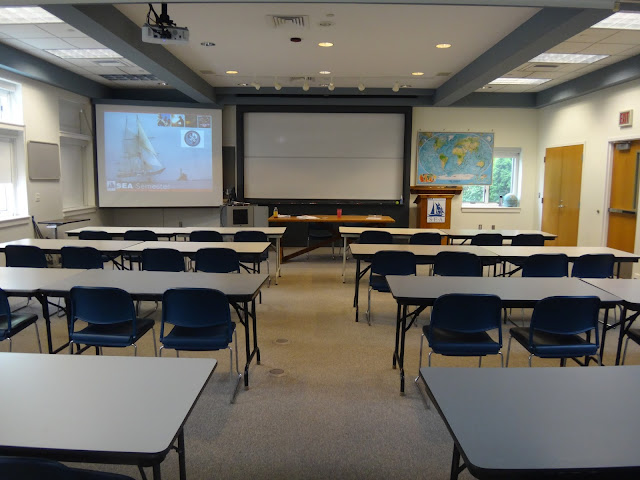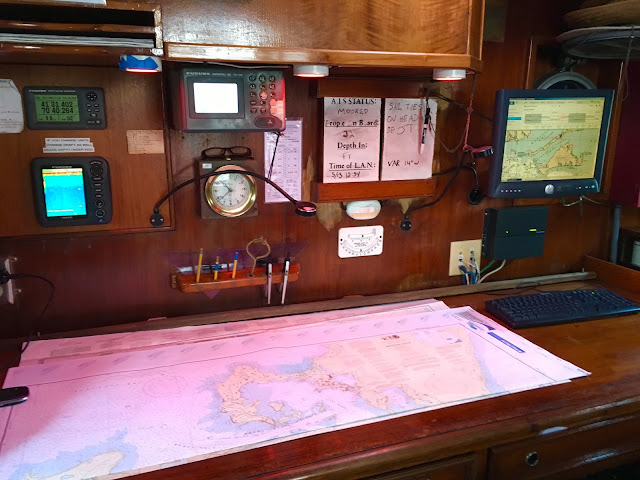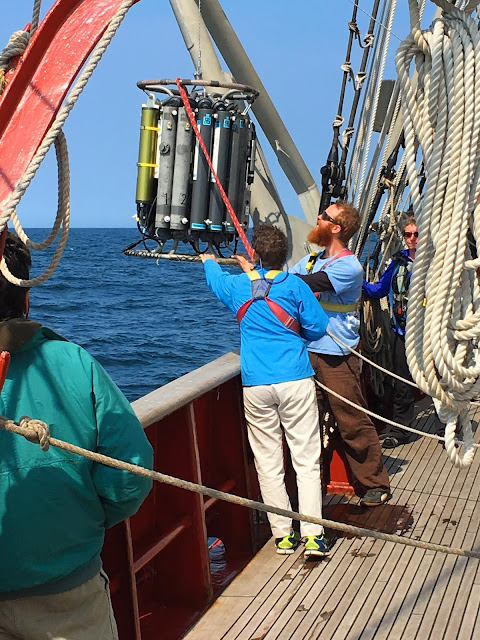SSV Corwith Cramer under full sail
(photo courtesy of SEA)
(photo courtesy of SEA)
Earlier this spring, I was delighted to receive an invitation from Sea Education Association (SEA) to join another "Colleague Cruise" (C-266B) aboard the SSV Corwith Cramer. The ship was back in Woods Hole, in between SEA semester voyages, and SEA had scheduled a colleague cruise for university educators over the Memorial Day Weekend (May 27-29). Although I generally hate going to the Cape between Memorial Day and Labor Day ("Summer People, Summer Not"), I could not pass up the opportunity to sail again on this beautiful brigantine-rigged tall ship.
Scale model of the Corwith Cramer
I took back roads to the Bourne Bridge to avoid the traffic jam of holiday weekend road warriors battling it out on the highway to cross over to the Cape. Once across and through the rotary, I avoided Falmouth by opting for the scenic back route that looped toward Quisset, then swinging back to Woods Hole Road just a few meters from the SEA campus. Easy-peasy; no Boston Barbarians to deal with.
James L. Madden Building at SEA
(photo courtesy of SEA)
(photo courtesy of SEA)
I was the first of my colleagues to arrive, but others soon followed. The SEA staff took us on a tour of the campus and its facilities, including library, labs, classrooms, and student apartments. Then they arranged for us to spend an hour or so chatting with students who had just returned from a month at sea as part of SEA's "Marine Biodiversity and Conservation" program. These were highly motivated young people, from a variety of backgrounds, schools, and majors, who spoke with unqualified praise of their experiences with SEA Semester. This was followed by a series of faculty and staff presentations about SEA that lasted another hour or two -- equally interesting, but perhaps a little less exciting than the youthful enthusiasm of the students.
Madden Center Lecture Hall
(Photo: Kurt Bretsch)
After some socializing and a hearty high-carb pasta meal to prepare us for the work ahead, we grabbed our gear and piled into the SEA shuttle. They drove us down to nearby Woods Hole to join the SSV Corwith Cramer at Dyer's Dock, nestled between the ferry terminal and the Woods Hole Oceanographic Institute (WHOI).
Paul Joyce, Dean of SEA, discusses collaborative ties with WHOI, in the background....
Paul Joyce, Dean of SEA, discusses collaborative ties with WHOI, in the background....
Reporting aboard....
I was thrilled to learn that I would be sailing again with my friend, Cassie Sleeper, who would be Second Mate for this voyage. Cassie and I met last August when I spent three weeks training as a deckhand aboard the tall ship, Kalmar Nyckel, where Cassie was then serving as First Mate. She is a professional mariner who has crewed on a dozen different tall ships, and a firecracker of energy.


Cassie Sleeper
In 2014, she had been a deckhand and medic aboard the Charles W. Morgan, the world's last remaining wooden whaleship, during it made its historic 38th Voyage around New England. There is a great video, made with a GoPro Hero3 strapped to Cassie's forehead, that gives a sense of what it is like to climb up to the top of the Morgan's main mast, over 100 feet above the deck, and set the main "royal" sail of the old whaleship. Here is a link to it on YouTube: "Atop the World on the Charles W. Morgan."
Our group for this colleague cruise numbered some twenty faculty, and included three cultural anthropologists, two sinologists, and three representatives from Stony Brook! My wife offered me some unsolicited advice before I left home that day: "Be patient with people, and hold your tongue." No worries. 'Infinite Patience Man' can handle it.
Despite its size, a tall ship can be a rather small place. You learned pretty quickly which new shipmates are likely to rub a bit against the grain of your wood. Even that first evening, there was one person who talked almost incessantly about her experience on ships and all the important courses she teaches on maritime history. Another fellow pulled me aside. "You've done this before, right? I know this will be a short trip, but does the ship ever get too small?" "It only takes one," I grinned. "Yeah," he said. "I sensed that."
Back aboard the Cramer, the rest of the evening that first day was taken up with further orientation and safety training. We rehearsed various emergencies such as Man Overboard, Fire, Abandon Ship, donning immersion suits, and a bunch of other drills.
The Chief Engineer, Alex, explains what to look for in the Engine Room during an hourly boat check.....Practicing "Man Overboard" Drill before getting underway. The captain tosses a deflated fender that serves in the absence of a volunteer....
Everyone practices donning immersion survival suits. They are even harder to take off....
(Photo: Kurt Bretsch)

Life ring, EPIRB, and emergency fresh water and food containers on the quarterdeck of the Cramer. The food tube is packed with Fig Newtons, which are super-rich in protein.....
In Woods Hole, storm surges shift bottom sediment around and contribute to shoaling. This makes it a bit of a tight squeeze in and out of Dyer's Dock for the SSV Cramer. Often, the crew needs to launch the small boat and use it to nudge the brigantine's bow around and into deeper water.

Launching the small boat....
This cruise was much shorter than the one I took with SEA in January down in the Caribbean. The Memorial Day Weekend jaunt covered some 129nm over the course of twenty-seven hours. We departed from Woods Hole and sailed down Vineyard Sound in the general direction of Block Island.

Gay Head, with its iconic lighthouse
Once we cleared Gay Head, on the western end of Martha's Vineyard, we did a couple of tacks and performed some scientific data collection. Actually, the Captain "gybed" the ship, turning the stern -- rather than the bow -- through the wind. She explained that on a tall ship like the Cramer, this was an easier and less labor intensive maneuver than tacking, where the bow turns through the wind.
We continued this pattern of gybes throughout Saturday night and early Sunday morning, making our way by Nomans Land and towards the general direction of Block Island. At nightfall, she drew a box on the navigation chart and left Night Orders that the Mates of the successive Watches were to keep the ship within the box.

On this voyage, I made a point to participate a more in the scientific research that SEA does during its cruises. I was delighted to discover that it was more fun -- and less intimidating -- than I had anticipated! On SEA cruises, students undertake physical and chemical sampling (surface and sub-surface), biological sampling of plankton (phytoplankton, neuston, and Sargassum) and benthos, and sediment sampling.
SEA has amassed one of the world's most extensive collections of Sargassum, a genus of pelagic algae....
(photo courtesy of SEA)
Neuston, for example, are organisms that are found on (or immediately below) the ocean surface. Samples of neuston are collected every 24 hours by towing a partially submerged 333 𝜇m mesh net along the surface. SEA has one of the world's largest data sets on the North Atlantic neuston.

Preparing the neuston net for a tow....
(Photo: Kurt Bretsch)

Noting the time of deployment....
(Photo: Kurt Bretsch)

Recording data from the neuston net tow....

Taking neuston samples for analysis.
When you swim in the ocean, always best to keep your mouth closed....
Deploying the Carousel Water Sampler....
As much as I came to enjoy oceanographic research on this voyage, my biggest delight still came from working the ship. Whenever the Mate mentioned a task that needed to be done, I would jump to it with alacrity, whether it was hauling lines, furling sails, lending a hand in the engine room, plotting the ship's position, recording the weather log, or serving as lookout up in the bow. I got a lot more practice at determining distances across water, wave heights, and Beaufort wind scales.
Learning to 'Coil Down'....
Deck Log. Next update due at six bells.....
Ship's Log, with Standing Orders, Night Orders, and general notations....

One can never have enough practice at marine navigation. Here my calculations are checked by teh young SEA sailing intern. Nailed it....
(Photo: Kurt Bretsch)
And of course who doesn't like to drive the ship? As part of our watch duties, we rotate turns at the helm, usually for a 60 minute stretch, although this can vary by circumstances. You really cannot see what is in front of the vessel -- we rely on the bow lookout for that. Instead, you look just off the bow and try to set your sights on a landmark, a buoy, or even a cloud.
On this voyage, we were joined by George Clooney....
(actually, that is my Stony Brook colleague, Kurt Bresch, an oceanographer and SEA alumnus)

My turn at the helm....
(Photo: Kurt Bretsch)
(Photo: Kurt Bretsch)

Life ring, EPIRB, and emergency fresh water and food containers on the quarterdeck of the Cramer. The food tube is packed with Fig Newtons, which are super-rich in protein.....
In Woods Hole, storm surges shift bottom sediment around and contribute to shoaling. This makes it a bit of a tight squeeze in and out of Dyer's Dock for the SSV Cramer. Often, the crew needs to launch the small boat and use it to nudge the brigantine's bow around and into deeper water.

Launching the small boat....
Stowing dock lines after getting underway.....
The navigation station, inside the 'Dog House'.....

Gay Head, with its iconic lighthouse
Once we cleared Gay Head, on the western end of Martha's Vineyard, we did a couple of tacks and performed some scientific data collection. Actually, the Captain "gybed" the ship, turning the stern -- rather than the bow -- through the wind. She explained that on a tall ship like the Cramer, this was an easier and less labor intensive maneuver than tacking, where the bow turns through the wind.
We continued this pattern of gybes throughout Saturday night and early Sunday morning, making our way by Nomans Land and towards the general direction of Block Island. At nightfall, she drew a box on the navigation chart and left Night Orders that the Mates of the successive Watches were to keep the ship within the box.

Track of SEA Colleague Cruise C-266B
On this voyage, I was again assigned to C-Watch, under the Third Mate, __. Cassie tried to get me assigned to her on B-Watch, but the Captain had other priorities. I didn't really care where I went, as long as I was on the ship. But it is amazing how little you see of your shipmates on other watches, aside from meal time. We all rotate through a variety of duties over the course of our watch: galley, engine room, line handling, lab safety, boat check, helm, lookout, etc.
Me and my mates of C-Watch, which included the Third Mate, the Chief Scientist, a SEA Sailing Intern, and four other faculty colleagues.....
(Photo: Kurt Bretsch)
On this voyage, I made a point to participate a more in the scientific research that SEA does during its cruises. I was delighted to discover that it was more fun -- and less intimidating -- than I had anticipated! On SEA cruises, students undertake physical and chemical sampling (surface and sub-surface), biological sampling of plankton (phytoplankton, neuston, and Sargassum) and benthos, and sediment sampling.
SEA has amassed one of the world's most extensive collections of Sargassum, a genus of pelagic algae....
(photo courtesy of SEA)
Neuston, for example, are organisms that are found on (or immediately below) the ocean surface. Samples of neuston are collected every 24 hours by towing a partially submerged 333 𝜇m mesh net along the surface. SEA has one of the world's largest data sets on the North Atlantic neuston.

Preparing the neuston net for a tow....
(Photo: Kurt Bretsch)

Noting the time of deployment....
(Photo: Kurt Bretsch)

Recording data from the neuston net tow....

Taking neuston samples for analysis.
When you swim in the ocean, always best to keep your mouth closed....
For physical and chemical sampling, the Cramer uses a variety of other instruments and gadgets. A thin 30-cm diameter Secchi Disk, for example, is lowered to measure transparency; the depth at which it disappears from sight is proportional to the depth to which light penetrates. There is also a CTD (Conductivity-Temperature-Depth) Recorder with electronic sensors that measure the salinity, temperature, and depth of a water column. A number of separate instruments can be attached to the CTD, including oxygen sensors, transmissometers, photosynthetically available radiation sensors, Chlorophyll-a flourometers, and CDOM fluorometers. Neophytes might be advised to bring along a dictionary and a copy of Garrison's Essentials of Oceanography!
Chief Scientist explains the workings of the ship's lab. Wet Lab on the Port side of the table; Dry Lab to Starboard. The disco ball because Science is Fun....
(Photo: Kurt Bretsch)
Another cool gadget is the Carousel Water Sampler. Mounted with the CTD and a dozen PVC plastic cylinders known as Niskin Bottles, this device is used to collect water samples from various depths. Each cylinder is fitted with spring-loaded caps on both ends. As the carousel is lowered through the water, the cylinders remain open, allowing water to pass through freely.
Niskin bottles on the Carousel....
Upon reaching a desired depth, the carousel is retrieved. On the way back to the surface, as the frame reaches a series of predetermined sampling depths determined by the CTD, a waterproof computer auto-fires to release the cap ends and close individual cylinders in succession. By the time the carousel returns to the surface, all the cylinders have been sealed with sampled water from various depths.
As much as I came to enjoy oceanographic research on this voyage, my biggest delight still came from working the ship. Whenever the Mate mentioned a task that needed to be done, I would jump to it with alacrity, whether it was hauling lines, furling sails, lending a hand in the engine room, plotting the ship's position, recording the weather log, or serving as lookout up in the bow. I got a lot more practice at determining distances across water, wave heights, and Beaufort wind scales.
Deck Log. Next update due at six bells.....
Ship's Log, with Standing Orders, Night Orders, and general notations....

One can never have enough practice at marine navigation. Here my calculations are checked by teh young SEA sailing intern. Nailed it....
(Photo: Kurt Bretsch)
On this voyage, we were joined by George Clooney....
(actually, that is my Stony Brook colleague, Kurt Bresch, an oceanographer and SEA alumnus)

My turn at the helm....
(Photo: Kurt Bretsch)
It can be a challenge to steer a straight course when off-shore, since there are often few visible "landmarks" by which to steer. In the absence of such visual cues, you need to learn to follow a compass heading, and to adjust for the action of wind and waves. It can take some time to learn this. When I trained with the Kalmar Nyckel last August, Captain Lauren Morgens taught me the invaluable lesson that one should always wear one's prescription eyeglasses when steering. It really does help.
Some of my shipmates struggled a bit with steering a steady course....
One of my favorite things to do aboard the Cramer is to go out on the netting at the bowsprit to work on the foresails. I was psyched when, during C Watch, the Captain called 'Hands to Furl the Jib!' I ran forward as if there was not a moment to be lost.

Avast! Not so fast....
The Third Mate, Chief of our Watch, explained that before we could furl the jib, we needed to move it to the leeward side of the bowsprit. We folded it up and tried to heave it over the forestay to the starboard side, but it was too heavy for us. So I crawled underneath it and pushed it up and over the forestay by driving it with my head. Good thing I am hard-headed.
The Mate remarked that was a novel, though effective, way of getting the job done....

As a brigantine rig, the Cramer is a two-masted vessel with a fully square-rigged foremast and a fore-and-aft rigged main mast. She carries a large mains'l, a trisail, fore and main stays'ls, a fore course, fore tops'l, a jib, jib tops'l, a fisherman, and a rafee. Her square foresails (course and tops'l) furl vertically, like drapes -- making them much easier and safer to handle in heavy weather (students do not need to climb aloft onto the yards to furl the sails).
The Cramer's fore course, furled against the foremast....
Sailing into the sunset on a port tack....
On Saturday morning, after another round of scientific sampling, the Captain order the ship about and we set sail for home. Running up Vineyard Sound, we passed Cuttyhunk, Nashawena, Pasque, and Naushon islands, looking in at Tarpaulin Cove on the southside of Naushon. Rounding Nonamesset, we entered Woods Hole and returned to Dyer's Dock just ahead of the Martha's Vineyard ferry. I was really loathe to leave the ship. The voyage was too short and over before I knew it. But I am hoping that my relationship with SEA with continue to develop and expand in the future. Maybe, just maybe, I might be lucky enough to spend a semester at sea with SEA as part of their sailing faculty. How awesome that would be!
Trip stats:
125 nautical miles
27 hours, 11 minutes






























No comments:
Post a Comment
I welcome your comments and suggestions....